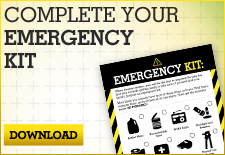
Disasters can happen… at any time. Be prepared to take action before, during and after.
Thunderstorms
On July 24th, 2012, an early morning thunderstorm hit downtown Chicago and parts of Northwest Indiana, toppling trees and downing power lines. The storm moved through Lake, DuPage, DeKalb, Kane and Kendall counties and the National Weather Service reported the line of storms to be capable of winds in excess of 70 mph. After the storm, 47,000 people in Illinois and 19,000 people in Indiana were without power.
On July 24th, 2012, an early morning thunderstorm hit downtown Chicago and parts of Northwest Indiana, toppling trees and downing power lines. The storm moved through Lake, DuPage, DeKalb, Kane and Kendall counties and the National Weather Service reported the line of storms to be capable of winds in excess of 70 mph. After the storm, 47,000 people in Illinois and 19,000 people in Indiana were without power.
Thunderstorms can be destructive and extremely dangerous weather emergencies. Thunderstorms bring high wings, heavy rains and dangerous lightning, one of the leading causes of weather‐related deaths in the United States each year. Being prepared in advance — and ready to act quickly — will help ensure your safety in the event that one of these weather emergencies occurs.
Every thunderstorm produces lightning, which means every thunderstorm is dangerous. Because lightning is so unpredictable and can occur as far as 10 miles away from any rainfall, being prepared and knowing what to do in a thunderstorm will decrease your risk of being injured. Other dangers associated with thunderstorms include tornadoes, strong winds, hail and flash flooding, which is responsible for more fatalities than any other thunderstorm‐associated hazard.
- Most lightning deaths and injuries occur when people are caught outdoors in the summer months during the afternoon and evening, so be particularly cautious of lightning at that time of year. If you see lighting you should seek shelter.
Know the difference between a Thunderstorm Watch and a Thunderstorm Warning:
There is a possibility of a thunderstorm in your area.
A thunderstorm is occurring or will likely occur soon. If you are advised to take shelter, do so immediately.
Before
You can find detailed information on your local TV and radio, the National Weather Service, your local government’s emergency management website and social like NOAA’s twitter and NOAA’s Facebook.
1 – Complete the Family Emergency Plan and discuss it as a family. This is a simple way of keeping each member of the family informed on critical information: where to reconnect should you become separated, who to call, and what you will do should a severe thunderstorm occur.
2 – Complete the Emergency Contacts Card and place one in your Emergency Kit.
3 – Prepare an Emergency Kit. The Emergency Kit should be easily accessible should you and your family be forced to shelter in place (stay at home) for a period of time.
- Remove dead or rotting trees and branches that could fall and cause injury or damage during a severe thunderstorm.
- Secure outdoor objects that could blow away or cause damage.
- Shutter windows and secure outside doors. If shutters are not available, close window blinds, shades or curtains.
- If a thunderstorm is likely in your area, postpone outdoor activities.
During
- Get inside a home, building, or hard top automobile (not a convertible). Although you may be injured if lightning strikes your car, you are much safer inside a vehicle than outside.
- Avoid the following:
– Natural lightning rods such as a tall, isolated tree in an open area.
– Hilltops, open fields, the beach or a boat on the water.
– Isolated sheds or other small structures in open areas.
– Anything metal, such as tractors, farm equipment, motorcycles, golf carts, golf clubs and bicycles. - Remember, rubber‐soled shoes and rubber tires provide NO protection from lightning. However, the steel frame of a hard‐topped vehicle provides increased protection if you are not touching metal.
- Avoid showering or bathing. Plumbing and bathroom fixtures can conduct electricity.
- Use a corded telephone only for emergencies. Cordless and cellular telephones are safe to use.
- Unplug appliances and other electrical items such as computers and turn off air conditioners. Power surges from lightning can cause serious damage.
- Listen for weather updates from local officials.
- In a forest, seek shelter in a low area under a thick growth of small trees. Avoid the tallest trees.
- In an open area, go to a low place like a ravine or valley, but watch for flooding.
- On open water, get to land and find shelter immediately.
- If you feel your hair stand on end, a lightning strike is about to happen:
– Squat low but don’t lie down.
– Place your hands over your ears and head between your knees.
– Make yourself the smallest possible target.
After
- Assess your immediate environment
- Report fallen trees, flooded streets, or damaged public utilities to the proper department
- Stay tuned to local weather stations for updated information



